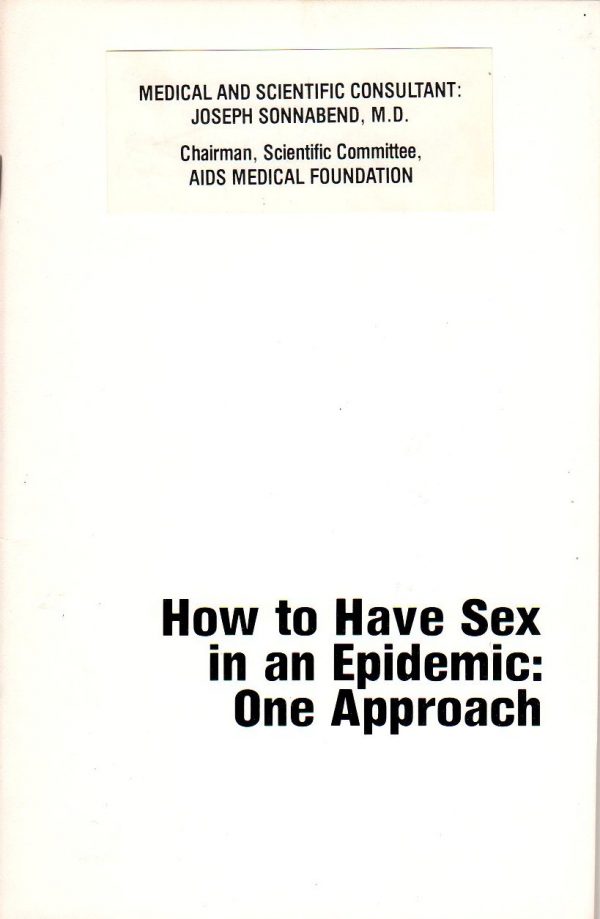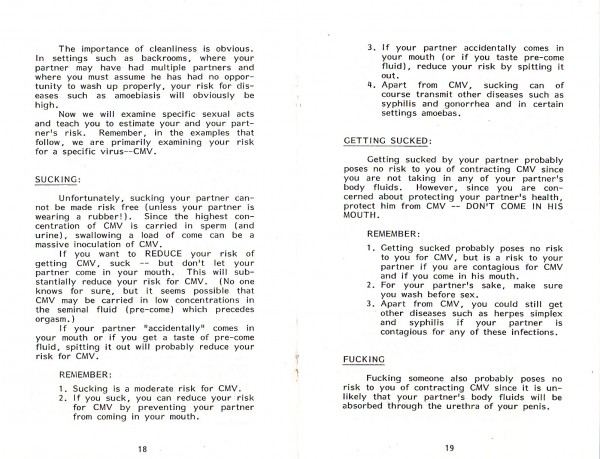I just finished watching Sex Positive, a documentary about Richard Berkowitz, who (along with singer and activist Michael Callen and physician Joseph Sonnabend) is largely responsible for the safer sex movement as we know it.
The film is probably most interesting because it’s complex. Berkowitz isn’t portrayed as a flawless hero and his fight to bring the truth about STD prevention to to the gay community in the early 80’s was a long and arduous battle. Berkowitz and his partners were working with the best of intentions but had little understanding of the disease, specifically what triggered AIDS. (HIV wasn’t discovered to have a connection until 1983 and it took years for activists and the medical establishment to acknowledge and accept it.)
Berkowitz’s message wasn’t well received. The gay community, coming out of the early struggles of the ’60s and ’70s and experiencing a sexual renaissance, wasn’t prepared to hear that their sexual behavior was putting them at risk for contracting a fatal disease. The history and impact of AIDS is intricately wrapped up with that of the gay community, and the front lines were fought in moral and political arenas rather than the medical and scientific arenas that they should have been. The result is an entire generation of dead gay men and the proliferation of a disease that’s now a global problem.
The one thing that Berkowitz hit on (even though his early facts were incorrect) was that sex could be made safer, and that it was possible to reduce the risk of infection without abstaining from sex altogether. In 1983 he wrote How to Have Sex in an Epidemic: One Approach, a thorough guide to safer sex. (Disclaimer: I haven’t read the pamphlet, and I can’t suggest—let alone promise—that it contains the best, accurate, science-based information.) The historical importance of the document can’t be ignored, though. Berkowitz’s insistence that people can still have sex as long as they take the necessary precautions and understand the risks helped shape the way sex education and the sex positive movement have grown to what they are today.
Sex Positive also briefly addresses that Berkowitz’s message is just as important today as it was back then. In 2007, the CDC released a study showing that the rate of HIV infections is on the rise.
- Gay, bisexual, and other men who have sex with men (MSM)1 represent approximately 2% of the US population, yet are the population most severely affected by HIV and are the only risk group in which new HIV infections have been increasing steadily since the early 1990s. In 2006, MSM accounted for more than half (53%) of all new HIV infections in the United States, and MSM with a history of injection drug use (MSM-IDU) accounted for an additional 4% of new infections. At the end of 2006, more than half (53%) of all people living with HIV in the United States were MSM or MSM-IDU. Since the beginning of the US epidemic, MSM have consistently represented the largest percentage of persons diagnosed with AIDS and persons with an AIDS diagnosis who have died.
- In 2006, more than 30,000 MSM and MSM-IDU were newly infected with HIV.
- Among all MSM, whites accounted for nearly half (46%) of new HIV infections in 2006. The largest number of new infections among white MSM occurred in those aged 30–39 years, followed by those aged 40–49 years.
Among all black MSM, there were more new HIV infections (52%) among young black MSM (aged 13–29 years) than any other racial or ethnic age group of - MSM in 2006. The number of new infections among young black MSM was nearly twice that of young white MSM and more than twice that of young Hispanic/Latino MSM.
- Among all Hispanic/Latino MSM in 2006, the largest number of new infections (43%) occurred in the youngest age group (13–29 years), though a substantial number of new HIV infections (35%) were among those aged 30–39 years.
- A recent CDC study found that in 2008 one in five (19%) MSM in 21 major US cities were infected with HIV, and nearly half (44%) were unaware of their infection. In this study, 28% of black MSM were HIV-infected, compared to 18% of Hispanic/Latino MSM and 16% of white MSM. Other racial/ethnic groups of MSM also have high numbers of HIV infections, including American Indian/Alaska Native MSM (20%) and Native Hawaiian/Pacific Islander MSM (18%).
- In 2007, MSM were 44 to 86 times as likely to be diagnosed with HIV compared with other men, and 40 to 77 times as likely as women.
- From 2005–2008, estimated diagnoses of HIV infection increased approximately 17% among MSM. This increase was likely due to a combination of factors: increases in new infections, increased testing, and diagnosis earlier in the course of infection; it may also have been due to uncertainty in statistical models.
- In 2008, an estimated 17,940 MSM were diagnosed with AIDS in the 50 states, the District of Columbia, and the US dependent areas—an increase of 6% since 2005.
- By the end of 2007, an estimated 282,542 MSM with an AIDS diagnosis had died in the United States and 5 dependent areas.
(quoted from the Center for Disease Control, “HIV among Gay, Bisexual and Other Men Who Have Sex with Men (MSM)“)
These are just a handful of statistics about a handful of the people who are affected by HIV and AIDS. It’s important that we continue educating people about risks and safer sex methods. I grew up in the post-AIDS-outbreak era and I understand the gay community’s need to be defined by something other than AIDS, but if we’re not careful and vigilant, it’s just as likely that our generation will be defined by AIDS as well.



Pingback: Tweets that mention Sex Positive St. Louis » Blog Archive » SEX POSITIVE: A documentary about the birth of safer sex -- Topsy.com
Pingback: Sex Positive St. Louis » Blog Archive » Brent’s Oral Exam: A cute, effective safer sex PSA